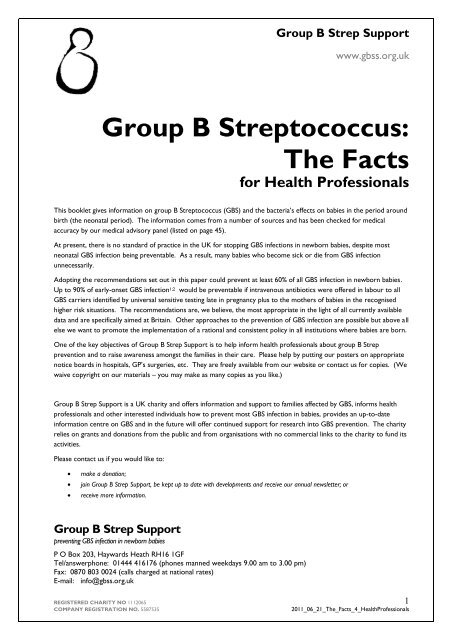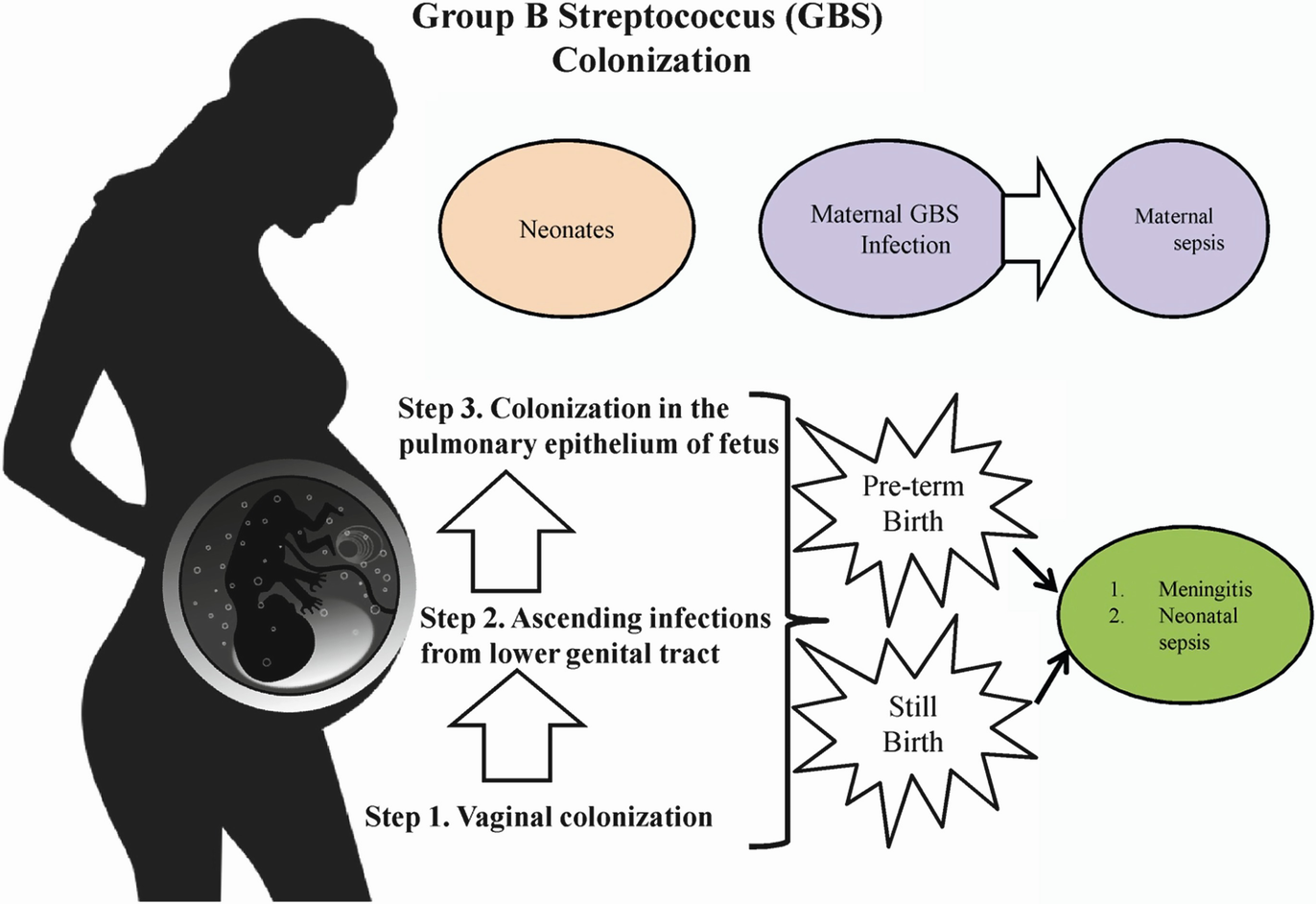Group B Streptococcus Isolated Not Pregnant
GBS bacteria can cause severe illness in pregnant women and newborns. Current Womens Health Reports 2002 4238-244.

The Double Life Of Group B Streptococcus Asymptomatic Colonizer And Potent Pathogen Abstract Europe Pmc
It is not only the leading cause of early-onset neonatal sepsis and meningitis first 28days of life but also has been associated with preterm labor premature rupture of membranes chorioamnionitis and puerperal and fetal infections in many countries 1 2 3.

Group b streptococcus isolated not pregnant. The present study evaluated the antimicrobial susceptibility of GBS isolates from pregnant women who were attended at a public health service in Northern. Streptococcus agalactiae Group B streptococcus GBS is the leading cause of neonatal infections in humans. This test is advised for all pregnant women.
In vitro resistance to macrolides and clindamycin by Group B Streptococcus isolated from pregnant and nonpregnant women. Verghese A Mireault K. GBS colonization of the female reproductive tract is of particular concern during pregnancy as the bacteria can invade gestational tissues or be transmitted to the newborn during passage through the birth canal.
Kasper DL Shimada J et al. It is an important cause of illness in pregnant women and the elderly with underlying illnesses such as diabetes mellitus or immunosuppression 13The organism is part of the normal flora of the gut and genital tract and is found colonizing 1040 of pregnant women. 2 Screening and Management Protocols for Group B Streptococcus in Pregnancy.
An optimal protocol for the prevention of neonatal sepsis has not yet been developed. Streptococcus agalactiae also called Group B Streptococcus GBS causes invasive infections mainly in pregnant women and neonates 1. Performance of a group B streptococcal prophylaxis protocol combining high-risk factors and low-risk screen.
Streptococcus agalactiae Group B Streptococcus GBS is a Gram-positive bacterium that is frequently isolated from the gastrointestinal and. Ekelund K Slotved HC Nielsen HU et al. Group B streptococcus is part of the normal bacteria that live in the body and anyone can become colonised with Group B streptococcus without having symptoms Group B streptococcus is transmitted to the baby during the birth in 12 per 1000 live.
J Clin Microbiol 2003. Its not routinely tested for but may be found during tests carried out for another reason such as a urine test or vaginal swab. J Infect Dis 1999.
Routine urine culture in pregnancy will identify and allow treatment of women with asymptomatic bacteriuria. While intrapartum antimicrobial prophylaxis appears to provide the best potential each of the currently suggested protocols. Isolation of the organism on surface areas the genital tract or the gastrointestinal tract only indicates colonization which may or may not be associated with invasive disease.
Group B Streptococcus GBS was the main causative organism of invasive infections in newborns due to vertical transmission from the colonized mothers. Invasive disease due to group B Streptococcus in pregnant women and neonates from diverse population groups. Temporary GBS colonization of the female urogenital tract is a known causative factor of neonatal infections acquired during the childbirth process.
Rapid antigen detection methodology is readily available primarily employing latex particle agglutination methodology. Group B strep in pregnancy Group B strep is common in pregnant women and rarely causes any problems. Streptococcus agalactiae also known as Group B Streptococcus GBS is a Gram-positive bacterium isolated from the vaginal tract of approximately 25 of women.
The bacteria may also inhabit or colonize your vagina and be passed on to your baby during labor and birth. Zaleznik DF Rench MA Hillier S et al. Group B Streptococcus GBS.
An estimated 10 to 30 percent of pregnant women carry group B strep in the vagina rectum or surrounding area. The study was undertaken to determine colonization rate serotype distribution genotypic characterization antibiotic susceptibility profiles and molecular characteristics of erythromycin-resistant strains of GBS in pregnant women in Beijing. This test looks for group B streptococcus GBS bacteria in a culture sample either from your urine or from secretions in your vagina and rectum.
Am J Obstet Gynecol 1826 pp 1335-43. J Infect Dis 1999. The bacteria are called hemolytic because they can break down red blood cells.
Serotypes VI and VIII predominate among group B streptococci isolated from pregnant Japanese women. The swabs were cultured on 5. Emergence of invasive serotype VIII group B streptococcal infections in Denmark.
Group B streptococcus is a significant pathogen for both mother and child. Group B streptococcus GBS is a kind of bacteria that many people naturally have in their intestinal tract. Streptococcus agalactiae or Group B Streptococcus GBS is the leading cause of neonatal morbidity and mortality resulting in septicaemia bacteraemia and meningitis.
Group B streptococcus GBS is the main pathogen of perinatal infection. 3 Reisner DP et al. Group B streptococcus GBS is one of the many bacteria that live in the body.
Lambiase A 1 Agangi A Del Pezzo M Quaglia F Testa A Rossano F Martinelli P Catania MR. Clin Infect Dis 2000. It usually does not cause serious illness and it is not a sexually transmitted infection STIAlso although the names are similar GBS is different from group A streptococcus the bacteria that causes strep throat.
Lachenauer CS Kasper DL Shimada J et al. This study has been performed to find the prevalence and serotypes of group B Streptococcus isolated from vagina of pregnant women in Nghe An province Vietnam. Serotypes VI and VIII predominate among group B streptococci isolated from pregnant Japanese women.
Vaginal swabs were collected from pregnant women at 35-37 weeks of gestation at the Nghe An Obstetrics and Pediatrics Hospital Vietnam between May 2018 and July 2019. Group B streptococcus GBS or Streptococcus agalactiae can colonize the gastrointestinal and genitourinary tracts and has been considered one of the most important risk factors for the development of neonatal disease. Long term problems in children range from loss of hearing to mental retardation.
Group B streptococcal antigen can be detected in approximately 90 of CSF specimens and 95 of.

The Fall And Rise Of Group B Streptococcus In Dairy Cattle Reintroduction Due To Human To Cattle Host Jumps Biorxiv

Disease Schema For Outcomes Of Maternal Group B Streptococcus Download Scientific Diagram

Epidemiology Of Group B Streptococcal Infection In Pregnant Women And Diseased Infants In Mainland China Sciencedirect

Perinatal Group B Streptococcal Infections Virulence Factors Immunity And Prevention Strategies Trends In Microbiology

Characterization Of Group B Streptococcus Colonization In Full Term And Late Preterm Neonates In Taiwan Pediatrics Neonatology

Additional Organisms Isolated From 14 Patients With Invasive Group B Download Table

Phylogenetic Analysis Of Group B Streptococcus Gbs With Emphasis On Download Scientific Diagram

Interaction Of Group B Streptococcus Gbs With Innate Immune Cells Download Scientific Diagram

Host And Bacterial Factors Contributing To Group B Streptococcus Download Scientific Diagram

Antibiotic Susceptibility Patterns Of Group B Streptococci Isolated Download Table

Epidemiology Of Group B Streptococcal Infection In Pregnant Women And Diseased Infants In Mainland China Sciencedirect

Global Distribution Of Group B Streptococcus Gbs Serotypes In Download Scientific Diagram

Group B Streptococcus The Facts Group B Strep Support

Information If You Re Not Pregnant Group B Strep Support

Advantages And Disadvantages Of Group B Streptococcus Gbs Carriage Download Table

Global Distribution Of Group B Streptococcus Gbs Serotypes In Download Scientific Diagram

Pathogenesis Virulence Factors And Antibiotic Resistance Of Group B Streptococcus Springerlink

Dual Actions Of Group B Streptococcus Capsular Sialic Acid Provide Resistance To Platelet Mediated Antimicrobial Killing Pnas

Supplemental Materials For Prevalence Of Maternal Colonisation With Group B Streptococcus A Systematic Review And Meta Analysis The Lancet Infectious Diseases
Post a Comment for "Group B Streptococcus Isolated Not Pregnant"